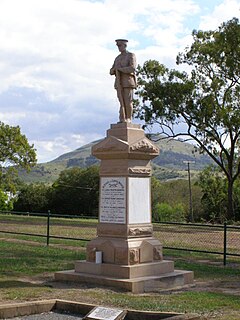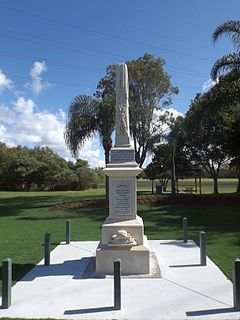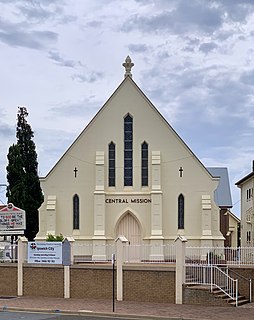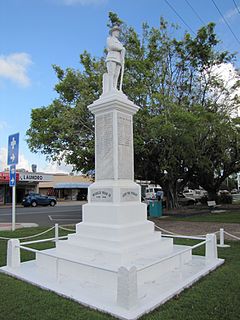
Mackay is a city in the Mackay Region on the eastern or Coral Sea coast of Queensland, Australia. It is located about 970 kilometres (603 mi) north of Brisbane, on the Pioneer River. Mackay is nicknamed the sugar capital of Australia because its region produces more than a third of Australia's sugar. In June 2018, Mackay had a population of 80,148, having decreased slightly at an average annual rate of -0.32% year-on-year over the preceding five years.

Esk is a town and locality in the Somerset Region in South East Queensland, Australia. In the 2016 census, Esk had a population of 1,698 people.

The Pioneer River is a river located in North Queensland, Australia. The 120-kilometre (75 mi) long river flows through the city of Mackay.

The City of Mackay was a local government area located in the Central Queensland region of Queensland, Australia, encompassing the regional city of Mackay and the surrounding region. The City was created as a municipal borough in 1869, and prior to amalgamation with the Shire of Pioneer in 1994, the City was limited to the central suburbs on the south shore of the Pioneer River. From 1994 until 2008, the City covered an area of 2,897.5 square kilometres (1,118.7 sq mi). In 2008, it amalgamated with the Shires of Mirani and Sarina to become the Mackay Regional Council.

Mirani is a town and locality in Mackay Region, Queensland, Australia. In the 2016 census, Mirani had a population of 1,541 people.

The Buttes New British Cemetery Memorial is a World War I memorial, located in Buttes New British Cemetery, near the town of Zonnebeke, Belgium. It commemorates 378 officers and men of the New Zealand Division who were killed in the vicinity and have no known grave.
The Mystery of Celtic Wood refers to the apparent disappearance without trace of 71 men of the 10th Battalion of the 1st Australian Division during a diversionary attack on German positions in Celtic Wood, near Passchendaele in West Flanders, during the Battle of Poelcappelle in the First World War. Official Army reports of the action state that investigations have failed to account for the fate of 37 men of the 10th Battalion. German records contain no mention of the attack, which led to speculation that the men were massacred and buried in a mass grave. Visitors to the site today are still given this explanation by guides. Rumours persist that the men had simply walked into a mist and disappeared. Some investigators attribute the lack of record of the missing to confusion, mis-reporting and clerical error.

The 25th Battalion, CEF was a unit in the Canadian Expeditionary Force during the Great War. It was the first of three to be raised entirely in Nova Scotia during the war. The 25th served in Belgium and France as part of the 5th Infantry Brigade, 2nd Canadian Division from 16 September 1915 until the end of the war. Regimental headquarters were established at the Halifax Armouries, with recruitment offices in Sydney, Amherst, New Glasgow, Truro and Yarmouth. Of the 1000 Nova Scotians that started with the battalion, after the first year of fighting, 100 were left in the battalion, while 900 men were killed, taken prisoner, missing or injured.

Goondiwindi War Memorial is a heritage-listed war memorial at Marshall Street, Goondiwindi, Goondiwindi Region, Queensland, Australia. The memorial includes a life-sized statue of a Digger and memorial gates . It is also known as Memorial Gates and The Soldiers' Memorial. It was added to the Queensland Heritage Register on 21 October 1992.

The 42nd Battalion was an infantry battalion of the Australian Army. Raised as part of the Australian Imperial Force (AIF) during the First World War, it was established at Enoggera in December 1915, forming part of the 11th Brigade in the 3rd Division. It subsequently served on the Western Front in France and Belgium in 1916–18 before being disbanded on 22 October 1918. In 1921, the battalion was reformed as part of the Citizens Forces becoming known as the 42nd Battalion. Following the outbreak of the Second World War the battalion held a number of training exercises and camps until 1941, before being mobilised in March 1942 as part of the 29th Brigade, in the 5th Division. It subsequently served in New Guinea fighting against the Japanese during 1943–44 and on Bougainville in 1945, before being disbanded on 7 May 1946. In 1948, it was reformed as part of the re-raised Citizens Military Forces. Today, its lineage is perpetuated by the 31st/42nd Battalion, Royal Queensland Regiment, a unit which continues to serve in the Australian Army Reserve.

Ma Ma Creek War Memorial is a heritage-listed memorial on the Gatton-Clifton Road, Ma Ma Creek, Queensland, Australia. It was completed in 1920. It was added to the Queensland Heritage Register on 21 October 1992.

Anning Monument is a heritage-listed memorial at the corner of Hemmant and Tingalpa Road and Boonoo Street, Hemmant, City of Brisbane, Queensland, Australia. It was designed and built by William Busby in 1903. It is also known as Hemmant Boer War Memorial. It was added to the Queensland Heritage Register on 21 October 1992.
George Brockwell Gill (1857–1954) was an architect in Ipswich, Queensland, Australia. Many of the buildings he designed are heritage-listed.

Ipswich Central Mission is a heritage-listed Uniting church at Ellenborough Street, Ipswich, City of Ipswich, Queensland, Australia. It was designed by Samuel Shenton and built in 1858 by Samuel Shenton. It is also known as Wesleyan Chapel, Ellenborough Street Church, and Ipswich City Uniting Church. It was added to the Queensland Heritage Register on 21 October 1992.

Finch Hatton railway station is a heritage-listed former railway station at Mackay-Eungella Road, Finch Hatton, Mackay Region, Queensland, Australia. It was built in 1904. It is also known as Hatton railway station and Pelion railway station. It was added to the Queensland Heritage Register on 6 December 2004.

Sarina War Memorial is a heritage-listed memorial at Broad Street, Sarina, Mackay Region, Queensland, Australia. It was built in 1919 by Melrose and Fenwick. It was added to the Queensland Heritage Register on 5 December 1997.

Mirani railway station is a heritage-listed former railway station on the former Pioneer Valley railway line at Victoria Street, Mirani, Mackay Region, Queensland, Australia. It was built from 1885 to 1913. It is also known as Hamilton railway station. It was added to the Queensland Heritage Register on 7 July 2005.

St Pauls Uniting Church is a heritage-listed church at 21 MacAlister Street, Mackay, Mackay Region, Queensland, Australia. It was designed by Walter Carey Voller and built from 1898 to 1918. It is also known as St Pauls Presbyterian Church. It was added to the Queensland Heritage Register on 21 August 1992.

War Memorial and Heroes Avenue is a heritage-listed memorial at Bungil Street, Roma, Maranoa Region, Queensland, Australia. It was built in 1920. It was added to the Queensland Heritage Register on 21 October 1992.



















